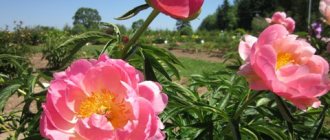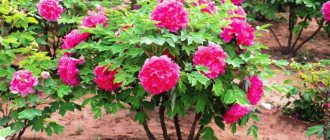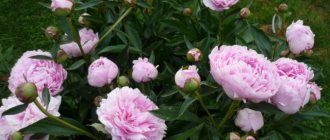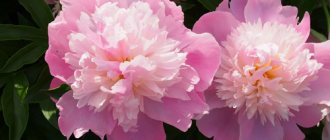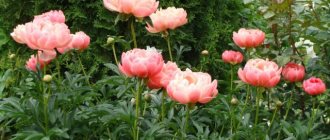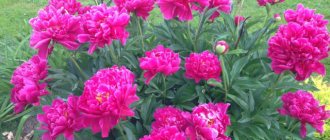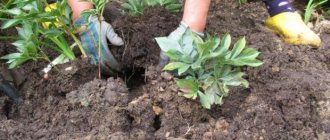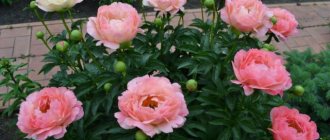Peonies created by crossing herbaceous and tree-like plants are called ITO hybrids. They became the embodiment of the dream of breeders to create varieties with yellow flowers. The hybrid bushes are tall, spreading, with many leaves that do not fall off after the first frost. One of the most beautiful and popular representatives of the group is the Bartzella peony. Large semi-double flowers delight with their rich yellow color and pleasant lemon aroma.
Semi-double peony "Bartzella"
How to plant: step-by-step instructions
Step-by-step instructions for planting peonies will be useful even for experienced gardeners. To avoid mistakes and plant the plant correctly, we recommend following our advice.
- First, prepare the seedlings. If you use flowers purchased for seedlings in pots, then before removing them, the soil must be moistened to free the roots without damaging the plant.
- The next step is to prepare the planting hole for the Bartzella peony. It needs to be dug up in advance so that the soil has time to become saturated with oxygen. The depth of the pit must be at least forty-five centimeters, and the radius must be at least seventy-five centimeters.
- It is necessary to lay a drainage layer at the bottom of the finished hole, which will prevent excess moisture from reaching the roots of the plant. For this purpose it is better to use fine gravel or sand.
- The next layer should be a mixture of fertile soil with mineral fertilizers. It needs to fill the hole approximately two-thirds.
- Now you should plant the seedling in open ground. This must be done in such a way that the buds of the plant are at the same level, and also recessed into the ground no more than five centimeters.
- If a seedling is planted from a pot, it should be lowered into the hole along with the soil in which it grew.
- Cover the planted peony with soil and compact it on top with your palm.
- Water the plants, allocating a bucket of water to each of them.
After the peonies are planted, the soil under them should be mulched to slow down the evaporation of moisture. In the next few weeks, until the roots are established, the crop needs to be provided with quality care.
Landing
A peony of this variety can grow in one place for decades. A well-lit and warm place is suitable for it. The plant should not be shaded by large trees or buildings. Bartzell's peony needs nutrient-rich soil, without stagnant water. The plant will not develop normally in airtight, heavy soils
During planting, you should pay attention to the fact that the buds are at a depth of five centimeters from the soil surface.
If the Bartzell peony is planted in violation of the rules of agricultural technology, the bush will not bloom. Varietal qualities after transplantation appear only in the second or third year. The planting hole is dug in advance so that the soil subsides. Its size for this variety is 60x60 cm. Its bottom is lined with a mixture consisting of:
- sand and peat;
- garden soil.
The plant requires primary feeding, which depends, first of all, on the composition of the soil. It is usually recommended to use the following composition:
- superphosphate (150 g);
- can of ash;
- iron sulfate (1 tablespoon).
It must be taken into account that the Bartzell peony loves neutral and slightly alkaline soils. Depending on the type of soil, the following fertilizers are added per square meter to the mixture of humus and manure for deoxidation:
- double superphosphate (1.5 cups);
- wood ash (300-500 g);
- dolomite flour (from 150 to 500 g);
- bone meal (2 cups).
A small amount of mineral fertilizers will not hurt either. All these components are mixed with soil, and then the hole is filled two-thirds with this mixture. The seedling is placed at a slight slope in the center. Renewal buds should be horizontal when planting. The root system is laid out on a small layer of sand, and the root collar must be sprinkled on all sides with a composition of sand and ash in equal proportions. This will minimize the possibility of rot on the roots.
When filling in the soil, make sure that the earthen lump above it is no more than five centimeters, otherwise this hybrid will not bloom. The plant does not like hollows in which moisture collects in the spring after the snow melts, and in the summer - rainwater. Peony does not like shade, but tolerates partial shade very well.
Peculiarities
Ito-hybrid "Bartzell" is a peony variety bred at the end of the last century by an American breeder named Roger Anderson. This variety was awarded two awards from the American Peony Society - for its attractive appearance and high decorative value. Let us give its description with all the main qualities.
Peony "Bartzella" is a herbaceous perennial. It can grow up to almost a meter in height and spread just as wide, resulting in a rather attractive ball of leaves and flowers.
This variety has thick, feathery, dark green leaves. They set off its large semi-double lemon-yellow flowers very well. Flowers, by the way, also grow quite densely, up to 60 buds on one bush, and are scattered along the entire perimeter of the bush from the very roots to the top. One flower can reach 25 centimeters in diameter.
Due to its shape and size, the flower is perfect for single planting. It can also be used to build flower arrangements. But be careful - the flower does not react well to other plants nearby, so try to pair it with something less demanding than itself.
The bush blooms once a year. Flowering begins in mid-June and continues until mid-July. True, for the first time the bush will delight you with flowers only 3 years after planting. During the flowering period, it gives off a very pleasant and delicate aroma. This variety is quite resistant to frost (withstands temperatures down to -30°C), and therefore its foliage lasts until November.
Varietal diversity
Over the years since the appearance of the first varieties of Ito-hybrids of peonies, breeders have developed a large number of their varieties. Each one differs in color, bush size, growing conditions - it’s difficult to choose the best. About 30 varieties are the most popular in Russia. Characteristics of some of them:
- Hillary is a spectacular variety of American selection with semi-double flowers with a diameter of up to 20 cm. The shade is carmine-cherry. The height of the bush reaches 55-60 cm. Feature of the variety: as the bud opens, the color of the flower changes - the stronger the opening, the lighter it is. Therefore, at the same time, inflorescences of different color saturation can be observed on the bush.
- Lollipop is a variety that connoisseurs call a masterpiece. Like Hillary, he appeared in 1999 in the USA. At the beginning of summer it opens with yellow flowers measuring 16-17 cm. The petals have strokes of red and purple shades, which in combination with the same middle of the flower looks very beautiful. Bush height - up to 80 cm.
- Bartzella is a hybrid bred in the USA in the late 90s of the last century. The buds bloom alternately in April-May with double yellow flowers, red in the center, up to 25 cm in size. The bush, almost 90 cm high, does not fade for a long time in the fall, changing the color of the foliage to bronze. Caring for the Bartzell peony, as well as planting it, are not difficult; it can grow in one place for decades. The peculiarity of the variety is that the flowers retain their freshness for a long time after cutting. In 2006, he was awarded a Gold Medal by the American Peony Society.
- Canary Diamonds - with semi-double yellow flowers and carmine strokes in the center. The diameter of the petals reaches 18 cm. The height of the bushes is 65-70 cm.
Reproduction of Bartzell's peony: the most common methods
The Bartzell peony is considered a rather rare and very valuable variety of this crop, so it is important to approach its cultivation on your own plot with the utmost seriousness and caution. From the experience of many gardeners who have come across this plant, it can be judged that propagation of the yellow Bartzell peony is a rather complex and troublesome process, and moreover, it is not always possible to achieve a positive result. The most optimal way to propagate the Ito-hybrid peony, which is Bartzella, is to divide the rhizome
This plant is not propagated by seeds, since it is almost impossible to obtain such planting material. You can also note propagation by cuttings - it is rarely used, but still has a right to exist. Let's consider the main characteristics of the reproduction of the Bartzell peony
The most optimal way to propagate the Ito-hybrid peony, which is Bartzella, is to divide the rhizome. This plant is not propagated by seeds, since it is almost impossible to obtain such planting material. You can also note propagation by cuttings - it is rarely used, but still has a right to exist. Let's consider the main characteristics of the reproduction of the Bartzell peony.
Reproduction by dividing Peony Bartzell's rhizomes
This method is not so complicated, the main thing is to do everything correctly and carefully. First of all, it is necessary to choose the right time for propagation by dividing the rhizome. This can be done in the spring around the end of April or early May, and also in the fall or at the end of August - beginning of September. If you have chosen spring division of the bush, then you need to be prepared for the fact that you will have to water the young plants more often and shade them from the sun. The most optimal is the autumn planting of the Bartzell peony, which is chosen by many gardeners. It is also worth remembering a few rules that can help you competently carry out the peony propagation process. You can divide the rhizome only from peony bushes that have reached 3-4 years old. First of all, you need to water the peony bush well to facilitate its further removal. This is due to the fact that the root system of the plant is quite extensive and the bush must be dug up in such a way as not to damage the numerous roots. After you dig up the bush, you need to shake it slightly to shake off the soil. Place the rhizome of the plant on the ground or on any covering material. Next begins a difficult stage, as it requires attentiveness and accuracy. The rhizome needs to be divided into 2 or sometimes 3 parts. In this case, a knife and pruning shears cannot always help. The peony rhizome is so thick and strong that you will need a hacksaw to cut the central log.
This tool must be used very carefully so as not to damage the root system. When dividing the rhizome, it is important to remember that each division must have at least 5 buds of renewed growth and the same number of roots. When dividing in autumn, you can focus on the shoots. After you have divided the root system of the plant, many experienced gardeners recommend treating the divisions with root formation stimulants, which will significantly speed up and simplify the rooting of the Bartzell peony. Next, the cut areas must be treated with a solution of potassium permanganate and sprinkled with crushed coal so that they dry and heal faster. It will take some time to dry, during which time you can prepare places for planting new plants.
Reproduction of Bartzell's peony by cuttings
- As noted above, there is another method of propagating the Bartzell peony - the cutting method, but it is used very rarely. This method is designed for long-term results, since flowering of young plants can only be expected after a few years. Cuttings are most often used to propagate particularly valuable varieties, such as the Bartzell peony, as well as to completely renew the root system.
- Bushes between 5 and 10 years old are suitable for this.
- It is best to prepare more cuttings, since their survival rate is quite low.
- The stems need to be cut close to the ground, after which they are divided into cuttings with two internodes on each.
- Before rooting, all cuttings are treated with growth stimulants.
- Rooting occurs in greenhouse conditions with high humidity. You can ventilate the cuttings only after 3 weeks gradually.
- Before winter, all cuttings are cut off above the ground and covered with fallen leaves on top.
- In spring they can be transplanted to a permanent place.
Reviews
Almost without exception, all reviews about the plant are positive and even admiring. Some note the high cost of the variety, however, they immediately mention the beautiful flowering and delicious aroma as compensation for the cost.
Many gardeners are glad that the peony tolerates winter well, and in many regions it does not even need shelter. Those who make bouquets mention that when cut, the Bartzell peony lasts for a long time without losing its decorative qualities.
We got acquainted with one of the most decorative varieties of peonies - Bartzella. This plant takes root well, tolerates our harsh winters well and annually pleases with magnificent flowering - which is not a reason to purchase a rare specimen and please yourself.
Characteristics and description of Ito-peonies
Japanese breeder Ito conducted more than 1,200 crosses before achieving the desired result. The main goal of the procedures was to obtain large-flowered peonies of yellow color. This could not be achieved by combining horticultural varieties, so Ito began combining herbaceous and tree varieties using his own unique genetic technique. Herbaceous and tree-like varieties combine the best qualities in Ito hybrids.
Ito peonies are strong, beautiful plants with a strong stem that stretches up to 100 centimeters. Characteristics of Ito peonies:
- the presence of large buds that reach a diameter of 20 centimeters;
- the petals are painted in rich, deep pastel colors;
- ability to bloom long and abundantly;
- the presence of a dense herbaceous stem, the branching of which is structured;
- the stem does not require garter;
- increased winter-hardy qualities.
Information! One of the differences between Ito peonies and herbaceous relatives is their weak aroma.
Necessary crop care
Planting and growing Ito hybrids is a process associated with constant control over the condition of the plant. Violations of the rules of care can lead to death or the development of diseases.
Watering and fertilizing
Watering is an important part of care. In the spring, plants are shed with a manganese solution to disinfect the soil. Then set a watering schedule. During the period of active growth and flower formation, bushes need a constant supply of moisture. Each bush is watered weekly in a specially dug furrow a few centimeters from the main stem. For each adult bush you will need 1-2 buckets of warm water. The soil around the plant must be kept moist, this is due to the structural features of the root system.
After flowering begins on the bush, watering is reduced. After flowering, a new stage begins when the soil must be constantly moistened. The bud formation of the next season depends on compliance with this rule.
Feeding is divided into several stages:
- Spring. Spilling manganese solution.
- Summer. Before flowering, superphosphate and potassium sulfate are added.
- Monthly. Application of mineral foliar mixtures.
- Pre-winter. Feeding using mineral compounds.
Mulching and loosening the soil
Peonies do not tolerate weeds growing near the stem. The root system of peonies, which is located at a distance from the main stem, needs a lot of free space; they cannot share it with other plants. Loosening the soil solves the problem of weed growth, while at the same time saturating the soil with oxygen, making it looser and lighter.
Mulching peonies solves several problems:
- protects against weeds;
- retains moisture;
- keeps warm;
- Helps protect against diseases and pest attacks.
Attention! For mulching, use pine bark, needles or freshly cut grass. If the grass begins to actively rot, then the layer of mulch must be replaced.
Treatment against pests and diseases
Tight, unopened buds often attract various pests. Aphids, bronzes, thrips - this is an incomplete list of peony lovers. They are destroyed using common insecticides or using proven folk remedies.
Peony bushes are especially loved by ants. The sweet syrup that the unopened bud secretes attracts ants, and they settle on the entire surface of the flower. One of the control options is to pour boiling water over the anthill, which is located near the bush.
Preventive measures that are carried out in spring and autumn protect against diseases.
Transfer
The best time to plant or replant a peony bush is the second half of August or the first half of September. At this time, the plants are going through a dormant period, so all procedures will be painless
The dates can be shifted at your discretion, but it is important to comply with the main requirement - the cuttings must take root before frost sets in.
Trimming
Pruning on the bush is carried out only when buds have successfully set after flowering. If you prune very early, the bush will not be able to form buds the next season. Ito hybrids are usually pruned only in the third year after the first flowering. The bush is cut to 15-20 centimeters, then mulched and covered for the winter. As for the removal of faded buds, it must be timely. Removing faded flowers will encourage further flowering.
Preparing for winter
The main technique for preparing Ito-peony bushes for winter is mulching. The soil is covered in such a way that the roots of the bush, located almost horizontally, are covered with a layer of mulch 10 centimeters thick. For mulch, you should use a soil mixture that will not change the acidity level.
In winter, despite the frost resistance of Ito varieties, it is necessary to additionally cover the bushes with non-woven material or special materials for the garden. This condition especially applies to young peony bushes that are not pruned.
Peonies and hybrids planting and care – Cottage, garden, vegetable garden, indoor plants
- 1 Ito-hybrids of peonies: photos, reviews, planting and care
- 2 ITO hybrids of peonies: the best varieties with photos and names, description of the species and rules for planting and care
- 3 ITO hybrids: what kind of peonies are they, their correct planting, care and reproduction
- 4 The best varieties of ITO-hybrid peonies: photos, descriptions, planting and care
- 5 Peonies ITO hybrids: description of varieties, planting, propagation and care
Peonies are native to Southeast Asia. These flowers were cultivated even before our era in China, Rome, and Greece. Over the millennia, many varieties of peonies have been developed. However, rich yellow flowers were obtained only in 1948 in Japan. The breeding work was carried out by scientist Toichi Ito. It was his name that was given to the new variety, which received many good reviews from lovers of ornamental plants.
Of course, many domestic gardeners would like to plant the Ito hybrid peony on their plot. What is the difference between it and ordinary varieties and how to properly care for such varieties - we will talk about this later in the article. In principle, such plants are relatively unpretentious. But of course, they should be watered and fertilized from time to time.
Planting peonies - Ito hybrids: preparing a flower bed
It is best to plant Ito peonies in late August - early September. The earth should be thoroughly loosened, getting rid of lumps. Small holes are dug under the plants themselves, so that after planting the buds are at a depth of 3-5 cm from the soil level. If they are too high or low, the peony will not bloom.
The dug holes are filled with pre-composed nutrient soil. Prepare a mixture of manure or humus and garden soil. To deoxidize, add a little ash or dolomite flour to the soil. Experienced gardeners also advise adding a little phosphorus fertilizer to the mixture.
The hole should be filled approximately 2/3 full. On dense soils, you can add a little sand to the mixture, on peaty soils - clay. The delenka in the pit is placed strictly in the center with a slight slope. Next, fill the hole completely with soil mixture.
ITO hybrids of peonies: the best varieties with photos and names, description of species and rules for planting and care
In nature, yellow herbaceous peonies are very rare. To decorate gardens with unusual flowers, breeders have crossed them with tree peonies for years. The first success was achieved by the Japanese scientist Toichi ITO.
The resulting plants were distinguished by their exceptional coloring, dense foliage and abundant flowering. The best varieties of ITO-hybrids of peonies have become thanks to the breeding work of American botanists.
The flowers are easy to care for, easily propagated by dividing the bush, and are resistant to low temperatures.
ITO peonies: varieties with photos and names
The hybrid group of peonies is a perennial with characteristics of herbaceous and tree-like plants. Varieties whose selection was based on the tree peony bloom at an earlier date.
Hybrids are characterized by variable petal color.
From tree peonies, the features of which can be read here “Tree peony is an obvious choice for the garden,” they inherited the presence of bright spots or shading on the flowers.
History of selection of ITO peonies
Thanks to interspecific hybridization, the world of peonies has been enriched with varieties with bright colors - red, pink, and then coral. But despite all their efforts, breeders for a long time were unable to obtain yellow herbaceous peonies - the long-time dream of flower growers. Success in creating yellow peonies came to the breeders of the Land of the Rising Sun before anyone else. In 1948, Japanese scientist and breeder Toichi Itoh selected a parent pair. The maternal variety was the herbaceous milky peony variety Kakoden, and the paternal variety was the yellow tree peony variety Kinko (AliceHarding). As a result of 1200 crossings, 6 plants with a yellow color were obtained. Ito was no longer alive when the plants fully bloomed. The work was completed by his widow and assistant.
Louis Smirnov, a Russian emigrant, owner of a nursery in the USA, purchased these new items from Ito's widow and then registered 4 yellow varieties in the American Peony Society (APS) Register in the herbaceous peonies section: Yellow Dream, Yellow Crown, Yellow Emperor and Yellow Heaven under the authorship of Ito -Smirnov. According to the rules, the first name belongs to the breeder, and the second to the owner of the rights. After the author's name they were called Ito-peonies.
Later, a separate section was identified in the AmOP Register: Intersectional Hybrids - “Intersectional hybrids”, implying their origin from peonies from different botanical sections: tree-like and herbaceous. As a result, both names are used: Itohhybrids and IntersectionalHybrids. Breeders continue intersectional hybridization using combinations of tree peonies (P. lutea) and tree peonies (P. suffructicosa) and herbaceous mother peonies that can set seed.
Bush pruning
Buds that appear in the first two years should be removed immediately. Such early flowers, as already mentioned, will not be beautiful. But they are quite capable of weakening the bush and slowing down its development.
For mature plants, pruning is done in mid-June. At this time, simply remove all dry inflorescences
When pruning, it is also important to remove all leaves and petals that have fallen to the ground. This is done to reduce the risk of developing fungal diseases. Actually, the very pruning of old flowers contributes to the laying of new buds of reproduction
The more of them are formed, the more magnificent and beautiful the peonies will be next year.
Actually, the very pruning of old flowers contributes to the laying of new buds of reproduction. The more of them are formed, the more magnificent and beautiful the peonies will be next year.
Growing problems
Since the plant is unpretentious, there should be no problems with cultivation. But, like all flowers in a flower bed, peonies can be attacked by pests, like ants that can eat inflorescences, spider mites, etc.
The fight against ants on peonies and other pests is carried out in this case in the same way as in cases of getting rid of insects when growing all other garden plantings.
Bartzell peonies in landscape design
Ito hybrids look great in landscape design. They can be used to decorate compositions or for single planting. Thanks to the stability of the peduncles, the bush retains its shape for a long time. Despite the large flowers, it remains unchanged, its stems do not fall down.
With the onset of the first autumn frosts, peony leaves remain the same decorative and do not lose their attractiveness. The aroma of the flowers and the long flowering period have made the flower very popular among gardeners.
Peonies look great in bouquets; when cut, they last a long time. If you plant a Bartzell peony in your garden and care for it properly, your garden will only benefit from it. During the flowering period it will have a fragrant aroma of flowers. With its large flowers it can decorate the landscape design of any garden.
Bartzella peony flower
Use Cases
The Bartzell shrub is beautiful as a solitary perennial, especially against the backdrop of neatly trimmed grass on a green lawn, and in group plantings, where roses and other peonies make the best company for it. Garden compositions that combine noble plants with lush inflorescences in a sunny shade and compact coniferous crops look very stylish. Decorative flowering bushes are used to divide a site into zones and to create borders for garden paths. The Bartzella hybrid can be planted near the gazebo, at the entrance to the flower garden, near the facade of the house under the window. Its gorgeous flowers are included in bouquets, since when cut, such buds retain their original fresh appearance for a long time.
Reproduction of Ito peonies: common methods
Ordinary peonies can be propagated by seeds and vegetatively, although the second method is much preferable. Ito peonies are hybrid varieties, so when propagated by seeds they will completely lose all species characteristics. In addition, getting seeds from flowers is also quite difficult. Therefore, the only way to get an Ito peony seedling is to propagate the bush using the rhizome division method. This is also a difficult method, but because of this the plant is considered very rare and expensive.
Reproduction of Ito peonies by division of rhizomes
- First of all, it is worth remembering that it is recommended to divide Ito peony bushes only when they reach the age of 5-6 years. Otherwise, the seedlings will not take root well and may die.
- In the future, Ito peony bushes must be divided every 2-3 years, since over time the root system becomes lignified. The fact is that the roots of such peonies are not simple tubers with buds, but a kind of logs with an isthmus. It's difficult to separate them.
- The best time to divide rhizomes is spring or autumn. If you choose spring, you must immediately decide where to plant the young plants, as they very quickly begin to take root and take root. However, the bad thing about spring is that you will always have to water the plant, since the roots grow slowly and cannot get water for themselves. Autumn time is more preferable for propagation, since the plant has time to get stronger and take root before the onset of winter.
- First of all, you need to carefully dig up the peony bush and shake off its roots from the ground.
- The output from one bush should be no more than 2-3 fragments. In this case, each fragment should have 3-5 buds and the same number of roots.
- It is recommended to divide the rhizome with a sharp hacksaw, making sure that the damage is even on all fragments.
- If there are small areas of rot on the roots, they must be cleaned off.
- Each division must be planted immediately, having previously been treated with growth stimulants.
- This method of propagation may seem difficult for an inexperienced gardener, but with a little skill everything will work out.
Preparing for winter
In the fall, after the end of the growing season, the leaves and stems of the Bartzell peony are cut almost to soil level. The root system tolerates sub-zero temperatures well, so there is no need for additional shelter from frost.
But it is better to cover young seedlings that have not had time to grow strong enough. To do this, use fallen leaves, straw or agrofibre.
Advice! In spring, the shelter is removed immediately after the thermometer rises to + 3 °C. Overheating of the root system can cause it to rot.
In autumn, the ground part of the peony is cut off
